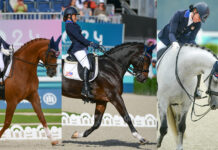
What does it look like when my horse is on the bit?
- Hindquarters: “You want to see active hindquarters and your horse stepping well under himself,” says Savoie.
- Back: Just behind the saddle, the back should look round, not dipped and hollow.
- Neck: If you’re sitting on your horse and looking at his neck, it should be widest at the base, just in front of the withers, and get progressively more narrow toward his ears. “If you’re looking at your horse’s neck from the side and you see a dip 4 or 5 inches in front of the withers (or a narrow area when viewed from above), that’s a visual signal that he is not really ‘through’ and connected,” says Savoie. “If the neck is widest in middle, or widest up by the ears, then your horse is being pulled into a frame instead of being correctly connected from back to front. He should get ‘pumped up’ or ‘bloom’ at the base of the neck, meaning it’s the widest point.”
- Poll: Ideally, the poll is the highest point.
- Nose: The nose should be 5 degrees in front of the vertical.
What does it feel like when my horse is on the bit?
- Suppleness & Connection: “You should feel an elastic connection with your horse’s mouth,” says Savoie. “His back should feel like it’s swinging underneath you; it shouldn’t feel rigid.”
- The Zone of All Possibilities: Your horse should feel ready to respond to any request within the next step. “If you want to go from trot to canter or do a leg-yield and your horse is really connected, these movements are simple,” Savoie explains. “If your horse is not connected, then those things become very complicated.” But if your horse is really on the bit, you can switch to a new gait or a different exercise almost just by thinking it, rather than actually applying aids.
- Horse and Rider Comfort: “For people who have trouble sitting to the trot or canter, the horse will become more comfortable to sit on when he’s connected, compared to when his back is hollow,” says Savoie. “From the horse’s point of view, he’ll also be more comfortable when you’re not pounding on his back and making him sore.”
Dressage Mysteries Solved Part I
Dressage Mysteries Solved Part II
Jane Savoie was the reserve rider for the 1992 U.S. Olympic dressage team in Barcelona, Spain, and has coached at three Olympic Games. She now travels throughout the country giving workshops and seminars. Her latest work includes the CD/DVD sets “Freedom from Fear,” “Program Your Position” and “A Happy Horse Home Study Course.” www.janesavoie.com






